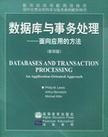数据库与事务处理
出版时间:2002-10 出版社:(影印版) (2002年1月1日) 作者:Lewis 页数:1014 字数:1620000
Tag标签:无
内容概要
进入21世纪,尤其随着我国加入WTO,信息产业的国际竞争将更加激烈。我国信息产业虽然在20世纪末取得了迅猛发展,但与发达国家相比,甚至与印度、爱尔兰等国家相比,还有很大差距。国家信息化的发展速度和信息产业的国际竞争能力,最终都将取决于信息科学技术人才的质量和数量。引进国外信息科学和技术优秀教材,在有条件的学校推动开展英语授课或双语教学,是教育部为加快培养大批高质量的信息技术人才采取的一项重要举措。为此,教育部要求由高等教育出版社首先开展信息科学和技术教材的引进试点工作。同时提出了两点要求,一是要高水平,二是要低价格。在高等教育出版社和信息科学技术引进教材专家组的努力下,经过比较短的时间,第一批引进的20多种教材已经陆续出版。这套教材出版后受到了广泛的好评,其中有不少是世界信息科学技术领域著名专家、教授的经典之作和反映信息科学技术最新进展的优秀作品,代表了目前世界信息科学技术教育的一流水平,而且价格也是最优惠的,与国内同类自编教材相当。这项教材引进工作是在教育部高等教育司和高教社的共同组织下,由国内信息科学技术领域的专家、教授广泛参与,在对大量国外教材进行多次遴选的基础上,参考了国内和国外著名大学相关专业的课程设置进行系统引进的。其中,John Wiley公司出版的贝尔实验室信息科学研究中心副总裁Silberchatz教授的经典著作《操作系统概念》,是我们经过反复谈判,做了很多努力才得以引进的。William Stallings先生曾编写了在美国深受欢迎的信息科学技术系列教材,其中有多种教材获得过美国教材和学术著作者协会颁发的计算机科学与工程教材奖,这批引进教材中就有他的两本著作。留美中国学者Jiawei Han先生的《数据挖掘》是该领域中具有里程碑意义的著作。由达特茅斯学院刀Thomas Cormen和麻省理工学院、哥伦比亚大学的几 位学者共同编著的经典著作《算法导论》,在经历了11年的锤炼之后于2001年出版了第二版。目前任教于美国Massachusetts大学的James Kurose教授,曾在美国三所高校先后10次获得杰出教师或杰出教学奖,由他主编的《计算机网络》出版后,以其体系新颖、内容先进而倍受欢迎。在努力降低引进教材售价方面,高等教育出版社做了大量和细致的工作。这套引进的教材体现了权威性、系统性、先进性和经济性等特点。本书描述数据库和事务处理应用软件的设计和实现的概念性原理和工程性原理,着重讲述如何构建数据库应用系统,并为此全面介绍关系数据库和关系查询语言的理论。 本书通过对运行案例的研究引发实际应用,使读者亲历设计、实现和测试数据库管理系统。讨论了实现事务处理应用系统时出现的重要的软件工程问题,并覆盖了网络贸易所引发的事务处理和安全问题。本书适用于数据库系统、数据库管理和设计、高级数据库课程。
作者简介
作者Philip M. Lewis、Arthur Bernstein、Michael Kifer均在美国纽约州立大学Stony Brook分校计算机科学系任教。
书籍目录
PrefacePART OneIntroduction 1 Overview of Databases and Transactions 1.1 What Are Databases and Transactions? 1.2 Features of Modern Database and Transaction Processing Systems 1.3 Major Players in the Implementation and Support of Database and Transaction Processing Systems 1.4 Decision Support Systems OLAP and OLTP 1.5 Exercises 2 A Closer Look 2.1 Case Study: A Student Registration System 2.2 IntToduction to Relational Databases 2.3 What Makes a Program a Transaction? 2.4 BibliographicNotes 2.5 Exercises 3 Case Study: Starting the Student Registration System 3.1 Software Engineering Methodology 3.2 Requirements Document 3.3 Requirements Analysis New Issues 3.4 Application Generators 3.5 GUIs and Objects 3.6 Events and Procedures 3.7 Accessing Databases and Executing Transactions 3.8 Specifying the Student Registration System 3.9 Specification Document 3.10 Bibliographic Notes 3.11 ExercisesPART TwoDatabase Management 4 The Relational Data Model 4.1 What Is a Data Model? 4.2 The Relational Model 4.3 SQL Data Definition Sublanguage 4.4 Bibliographic Notes 4.5 Exercises 5 Database Design l: The Entity-Relationship Model 5.1 Conceptrial Modeling with the E-R Approach 5.2 Entities and Entity Types 5.3 Relationships and Relationship Types 5.4 Advanced Features of the E-R Approach 5.5 A Brokerage Firm Example 5.6 Limitations of the E-R Approach 5.7 Case Study: A Design for the Student Registration System 5.8 Bibliographic Notes 5.9 Exercises 6 Query Languages l: Relational Algebra and SQL 6.1 Relational Algebra: Under the Hood of SQL 6.2 The Query Sublanguage of SQL 6.3 Modifying Relation Instances in SQL 6.4 Bibliographic Notes 6.5 Exercises 7 Query Languages II: Relational Calculus and Visual Query Languages 7.1 Tuple Relational Calculus 7.2 Understanding SQL through Tuple Relational Calculus 7.3 Domain Relational Calculus and Visual Query Languages 7.4 Visual Query Languages: QBE and PC Databases 7.5 The Relationship between Relational Algebra and the Calculi 7.6 Recursive Queries in SQL:1999 7.7 Bibliographic Notes 7.8 Exercises 8 Database Design II: Relational Normalization Theory 8.1 The Problem of Redundancy 8.2 Decompositions 8.3 Functional Dependencies 8.4 Properties of Functional Dependencies 8.5 Normal Forms 8.6 Properties of Decompositions 8.7 An Algorithm for BCNF Decomposition 8.8 Synthesis of 3NF Schemas 8.9 The Fourth Normal Form 8.10 Advanced 4NF Design 8.11 Sununary of Normal Form Decomposition 8.12 Case Study: Schema Refinement for the Student Registration System 8.13 Tuning Issues: To Decompose or Not to Decompose? 8.14 Bibliographic Notes 8.15 Exercises 9 Triggers and Active Databases 9.1 Semantic Issues in Trigger Handling 9.2 Triggers in SQL:1999 9.3 Avoiding a Chain Reaction 9.4 BibliographicNotes 9.5 Exercises 10 SQL in the Real World 10.1 Executing SQL Statements within an Application Program 10.2 Emtredded SQL 10.3 More on Integrity Constraints 10.4 DynandcSQL 10.5 JDBC and SQLJ 10.6 ODBC 10.7 Comparison 10.8 Bibliographic Notes 10.9 Exercises 11 Physical Data Organization and Indexing 11.1 Disk Organization 11.2 Heap Files 11.3 Sorted Files 11.4 Indices 11.5 Multilevel Indexing 11.6 Hash Indexing 11.7 Special--Purpose Indices 11.8 Tuning Issues: Choosing Indices for an Application 11.9 Bibliographic Notes 11.10 Exercises 12 Case Study: Completing the Student Registration System 12.1 The Design Document 12.2 TestPlan 12.3 Project Planning 12.4 Coding 12.5 Incremental Development 12.6 Design and Code for the Student Registration System 12.7 Bibliographic Notes 12.8 Exercises 1 3 The Basics of Query Processing 13.1 EXternalSorting 13.2 Computing Projection, Union, and Set Difference 13.3 Computing Selection 13.4 Computing Joins 13.5 Multi--RelationalJoins 13.6 Computing Aggregate Functions 13.7 Tuning Issues: Impact on Physical Database Design 13.8 Bibliographic Notes 13.9 Exercises 14 An Overview of Query Optimization 14.1 OVerview of Query Processing 14.2 Heuristic Optimization Based on Algebraic Equivalences 14.3 Estimating the Cost of a Query Execution Plan 14.4 Estimating the Size of the Outout 14.5 Choosing a Plan 14.6 Tuning Issues: Impact on Query Design 14.7 Bibliographic Notes 14.8 Exercises 15 An Overview of Transaction Processing 15.1 Isolation 15.2 Atomicity and Durability 15.3 Implementing Distributed Transactions 15.4 Bibliographic Notes 15.5 ExercisesPART ThreeAdvanced Topics in DatabasesPART FourTransaction Processing
媒体关注与评论
本套教学用书的特点: 权威性——教育部高等教育司推荐、教育部高等学校信息科学与技术引进教材专家组遴选 系统性——覆盖计算机专业主干课程和非计算机专业计算机基础课程 先进性——著名计算机专家近两年的最新著作,内容体系先进 经济性——价格与国内自编教材相当、是国内引进教材价格最低的
图书封面
图书标签Tags
无
评论、评分、阅读与下载
用户评论 (总计0条)
相关图书
- 软件项目管理
- 算法Ⅰ~Ⅳ(C++实现):基础、数据结构、排序和搜索
- 算法V
- 多线程,并行与分布式程序设计基础(影印版)
- CMM实现指南
- CMM实践
- 基于项目的软件工程
- 项目管理
- 软件体系结构(影印版)
- 电路分析基础(影印版)(附光盘) (平装)
- 生物反馈的临床实践
- 简明人类遗传学
- 生物化学-(影印版)
- 土壤物理学
- 社会学专业主干课程教学基本要求
- 导游业务
- 法律逻辑学教程
- 当代英语搭配大词典
- 信息论基础
- Visual Basic程序设计简明教程
- Java语言程序设计
- 计算机组成原理复习与考试指导
- 计算机教学软件的开发与管理
- 全国计算机等级考试二级Visual Basic达标辅导
- 全国计算机等级考试三级基础知识与PC技术达标辅导
